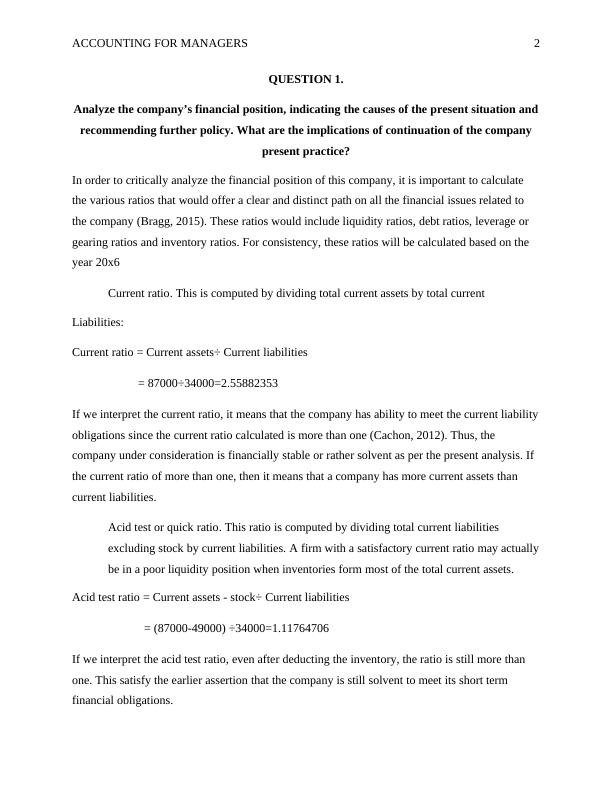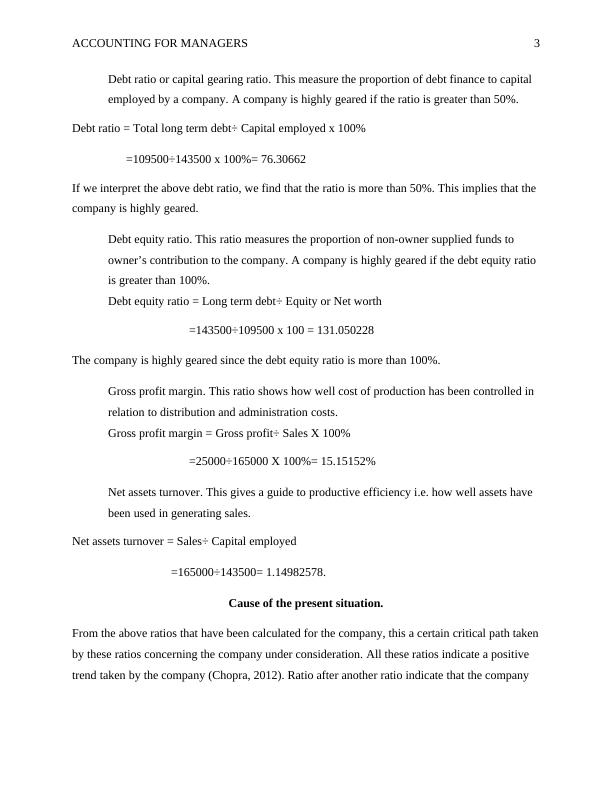ACC701 Accounting for Managers
13 Pages3763 Words41 Views
university of sunshine coast
Accounting Financial (ACC701)
Added on 2020-05-04
ACC701 Accounting for Managers
university of sunshine coast
Accounting Financial (ACC701)
Added on 2020-05-04
ShareRelated Documents
ACCOUNTING FOR MANAGERS1ACCOUNTING FOR MANAGERSName:Institution:Course Code:

ACCOUNTING FOR MANAGERS2QUESTION 1.Analyze the company’s financial position, indicating the causes of the present situation andrecommending further policy. What are the implications of continuation of the companypresent practice?In order to critically analyze the financial position of this company, it is important to calculate the various ratios that would offer a clear and distinct path on all the financial issues related to the company (Bragg, 2015). These ratios would include liquidity ratios, debt ratios, leverage or gearing ratios and inventory ratios. For consistency, these ratios will be calculated based on the year 20x6Current ratio. This is computed by dividing total current assets by total currentLiabilities:Current ratio = Current assets÷ Current liabilities= 87000÷34000=2.55882353If we interpret the current ratio, it means that the company has ability to meet the current liabilityobligations since the current ratio calculated is more than one (Cachon, 2012). Thus, the company under consideration is financially stable or rather solvent as per the present analysis. If the current ratio of more than one, then it means that a company has more current assets than current liabilities.Acid test or quick ratio. This ratio is computed by dividing total current liabilities excluding stock by current liabilities. A firm with a satisfactory current ratio may actuallybe in a poor liquidity position when inventories form most of the total current assets.Acid test ratio = Current assets - stock÷ Current liabilities= (87000-49000) ÷34000=1.11764706If we interpret the acid test ratio, even after deducting the inventory, the ratio is still more than one. This satisfy the earlier assertion that the company is still solvent to meet its short term financial obligations.

ACCOUNTING FOR MANAGERS3Debt ratio or capital gearing ratio. This measure the proportion of debt finance to capital employed by a company. A company is highly geared if the ratio is greater than 50%.Debt ratio = Total long term debt÷ Capital employed x 100%=109500÷143500 x 100%= 76.30662If we interpret the above debt ratio, we find that the ratio is more than 50%. This implies that the company is highly geared.Debt equity ratio. This ratio measures the proportion of non-owner supplied funds to owner’s contribution to the company. A company is highly geared if the debt equity ratio is greater than 100%.Debt equity ratio = Long term debt÷ Equity or Net worth=143500÷109500 x 100 = 131.050228The company is highly geared since the debt equity ratio is more than 100%.Gross profit margin. This ratio shows how well cost of production has been controlled in relation to distribution and administration costs.Gross profit margin = Gross profit÷ Sales X 100%=25000÷165000 X 100%= 15.15152%Net assets turnover. This gives a guide to productive efficiency i.e. how well assets have been used in generating sales.Net assets turnover = Sales÷ Capital employed=165000÷143500= 1.14982578.Cause of the present situation.From the above ratios that have been calculated for the company, this a certain critical path takenby these ratios concerning the company under consideration. All these ratios indicate a positive trend taken by the company (Chopra, 2012). Ratio after another ratio indicate that the company

ACCOUNTING FOR MANAGERS4financial position is well established. The causes of that positive trend in the present situation may be attributed by several aspects.The company is operating of assets rather than the liabilities. This implies that, the company is ina position to reinvest the profit generated unlike a case where the profits would have been used to pay both current and non-current liabilities.The goods and services offered by the company are having high demands and more sales. This make the company to have positive trend.Recommendation of further policies.The company need to maintain upward trends in asset relocation while on the other hand reduce the liabilities in the present situation (Christopher, 2011). This will add value to the company financial position and may as well assist in reinvesting the accrued profits.It is appropriate to reward the employees from the profits generated. This in return motivate them. They are able to set higher targets in the following financial years which will as well immerse more profits in the future. This can be classified as a future financial strategy.Implications of continuation of the company present practice.From the present practice, the following implications will arise.The company will undergo significant growth and development in terms of capital utilization, wealth creation and value of the company.The company is likely to add more services and goods offered due to his possibility of reinvestment of extra profits generated from the sales.Indicate any limitations of your analysis.There are various limitations that are likely to affect this analysis. First, there is limitation associated to data. This data has been analyzed from the present year of financial obligation (Daft, 2015). Therefore, it has not been compared to other previous years so as to determine the actual trend. Again, these data has been obtained from accounting documents that are subjected to manipulation so as to fit the company’s aims. It is important also to consider the audited data to clarify whether there has been data manipulation for any reason whatsoever.

End of preview
Want to access all the pages? Upload your documents or become a member.
Related Documents
Financial Management of ATC Company - Management Accounting Informationlg...
|7
|441
|489
Financial Management for Hotel Industrylg...
|14
|3273
|93
MOD003459 Financial Reporting for Businesseslg...
|15
|3422
|72
Financial Management of ATC Companylg...
|7
|468
|181
Asset Utilization Ratio - Assignmentlg...
|8
|1258
|135
ASSESSMENT | FINANCIAL MANAGEMENTlg...
|9
|1381
|15
